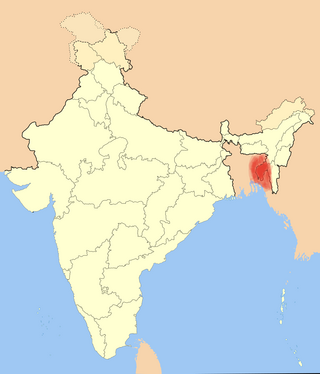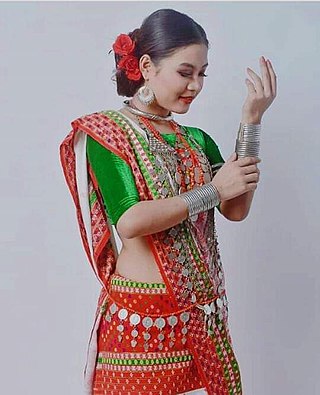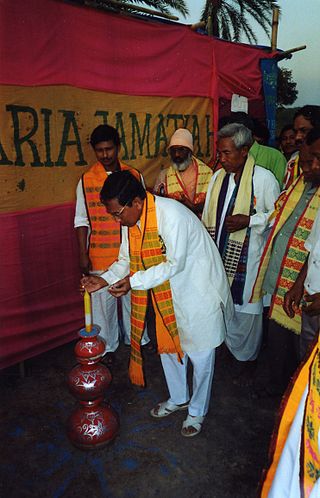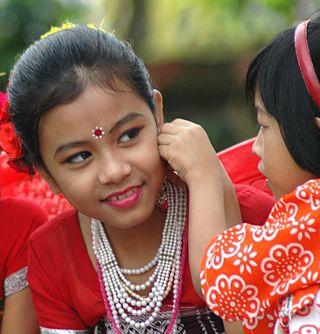Related Research Articles

Tripura is a state in Northeast India. The third-smallest state in the country, it covers 10,491 km2 (4,051 sq mi); and the seventh-least populous state with a population of 36.71 lakh. It is bordered by Assam and Mizoram to the east and by Bangladesh to the north, south and west. Tripura is divided into 8 districts and 23 sub-divisions, where Agartala is the capital and the largest city in the state. Tripura has 19 different tribal communities with a majority Bengali population. Bengali, English and Kokborok are the state's official languages.

Kokborok (or Tripuri) is a Tibeto-Burman language of the Indian state of Tripura and neighbouring areas of Bangladesh.

The Tripura Tribal Areas Autonomous District Council(TTAADC) is an autonomous district council administering the Tipra-dominated areas of the state of Tripura, India. Its council and assembly are situated in Khumulwng, a town 26 km away from Agartala, the state capital.
Khumulwng is a town in the West Tripura district in the Indian state of Tripura. It is the headquarters and the largest town of the Tripura Tribal Areas Autonomous District Council.

The Tripuri, are a Tibeto-Burman-speaking ethnic group of Northeast Indian state of Tripura. They are the descendants of the inhabitants of the Twipra/Tripura Kingdom in North-East India and Bangladesh. The Tripuri people through the Manikya dynasty ruled the Kingdom of Tripura for many years until the kingdom joined the Indian Union on 15 October 1949.
The Dances of Tripura refer to several forms of folk dance performed in the state of Tripura in northeastern India. These dances are performed by the Tripuri and Mog peoples, during annual regional celebrations, such as sowing and harvesting festivals.

The 'Jamatias' are the one of the main Tripuri clans of Tripura and the only such clan with its own Customary law in practice, which is called Jamatia Raida.

Jamatia Hoda is the institution that looks after the rights and safeguard of the culture of the Jamatia clan of Tripuri community. It has head-office in Atharobla in Udaipur town of South Tripura district of Tripura and a branch office at Khejurbagan, Agartala near Sri Krishna Mission School. It has also started a higher secondary school named Garia Academy. in Atharobla. It is affiliated to CBSE board.
Reang is a Tripuri clan of the Indian state of Tripura. The Reangs can be found all over the Tripura state in India. However, they may also be found in Assam and Mizoram. They speak the Kokborok language which is known as Kaubru in Reang dailect.

Koloi is one of Tripuri clan in Tripura state of India. They are mainly dwelling in the West Tripura districts. They speak the language Kokborok (Tripuri) which is of Tibeto-Burmese origin.
Uchoi is one of Tripuri clan lives in Tripura state of India and Bangladesh. They speak the language Kokborok which is of Tibeto-Burmese and their dialect is similar with Reang tribe. The largest religions practiced are Christianity followed by Buddhism and also few numbers following Hinduism.
The tribal people of Bangladesh are ethnic minorities in Chittagong Hill Tracts (southeastern), Sylhet Division (northeastern), Rajshahi Division (west), and Mymensingh Division (north-central) areas of the country. They are indigenous and the tribal races, total population of ethnic minorities in Bangladesh was estimated to be over 2 million in 2010. They are diverse ethnic communities including Tibeto-Burman, Austric and Dravidian people.
The Halam community are various tribes native to the state of Tripura in India. The name Halam was coined by the Tipra Maharaja. As per their oral tradition they called themselves "Riam", which literally means "Human being". And lyrically they also call themselves "Riamrai, Raivon, Longvon, Chepvon etc.". The Halam are further divided into 12 sub-tribes, namely Chorai, Molsom, Hrangkhol, Kaipeng, Kalai, Ranglong, Sakachep, Thangachep, Bongcher, Korbwng, Dab and Rupini.

The culture of Tripura is distinct and a bit similar to other people of Northeast India. However like Assam, Manipur, Burma and Southeast Asia culture of Tripura is characterized in small portion where people live in plain and hill areas. Tripura is a state in North East India. In the 2001 census of India, Bengalis represented almost 70% of the population and the Tripuri population comprised 30% of Tripura's population. The Tripuri population comprises some clans and ethnic groups with diverse languages and cultures. The largest native group was the Tripuri who had a population of 543,848 in 2001 census, representing 16.99% of the state population and 54.7% of the scheduled tribe population. The other group of people in order of decreasing population were Chakma (6.5%), Halam (4.8%), Mog (3.1%), Munda, Kuki tribes and Garo Hajong. Bengali is the most spoken language, due to the dominance of Bengali people in the state. Kokborok (Tripuri/Tiprakok) is a common language among Tripuris and lingua franca in Tripura. Several other languages belonging to Indo-European and Sino-Tibetan families are spoken by the different tribe

Sipahijala District is a district of Tripura, India. This district was created in January 2012 when four new districts were established in Tripura, taking the number of districts in the state from four to eight. Part of the district was formed from the former district of West Tripura. The principal towns in the district are Bishalgarh, Bishramganj, Melaghar and Sonamura.
Kokborok Day is a festival celebrated in the Indian state of Tripura to celebrate the development of the Kokborok language. It is observed on 19 January every year. The Kokborok language is an official language in Tripura. This day is chosen to commemorate its initial recognition as an official language in 1979. The activities include cultural programmes and literary activities.

The following outline is provided as an overview of and topical guide to Tripura:
Mamita Festival is a festival is observed in Tripura by the Tripuri, Jamatia, and Noatia people after harvesting various crops including rice, sesame, vegetables, etc from the jhum or paddy field. In this day Tripuri people worship Mailuma and Khuluma deities by offering newly harvested crops. On this day a dance is performed by group of young male and females named" Mamita dance.
Atul Debbarma is an Indian doctor-turned-politician and author. He was a practicing doctor in the Municipal Corporation of Delhi until December 2017. He became involved with Rashtriya Swayamsevak Sangh (RSS) and its different wings such as Vanvasi Kalyan Ashram and Vivekananda International Foundation in 2007. He won the Tripura Assembly Elections 2018 as the BJP candidate from Krishnapur constituency.
Sudhanwa Debbarma was an Indian Kokborok writer, Political leader and member of the Communist Party of India (Marxist). He was the former Speaker of Tripura Legislative Assembly. He was the veteran leader of Ganamukti Parishad. He was a member of Tripura Legislative Assembly from Takarjala (1977-1988).
References
- ↑ "Happy Kokborok Day 2023: What is Kokborok Day and why it is celebrated?". Jagranjosh. 19 January 2023.
- ↑ "Tripura celebrates 43rd Kokborok Day". Northeast Now. Retrieved 20 January 2023.
- ↑ De, Nilanjan (April 2019). ""Jamai Khata - An apprenticeship of a bridegroom": An analytical study on an ageold tradition of the Tripuri community of Tripura". Journal of Emerging Technologies and Innovative Research (JETIR). 6 (4): 704. ISSN 2349-5162 . Retrieved 20 January 2023.
- ↑ "Noatia". Tribal Research and Culture Institute. Retrieved 20 January 2023.
- ↑ Debbarma, Moushami (2018). Dresses and Ornaments of the Tribes of Tripura (PDF). Tribal Research and Cultural Institute. ISBN 978-93-86707-19-2.
